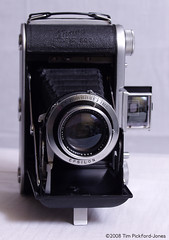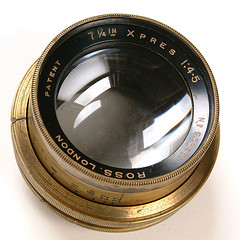Difference between revisions of "Ross Xpres"
(Updated cineressources links) |
m (Reverted edits by Nparsons13 (talk) to last revision by Dustin McAmera) (Tag: Rollback) |
||
| (2 intermediate revisions by 2 users not shown) | |||
| Line 1: | Line 1: | ||
| − | The '''Xpres''' is a very successful lens made by the British maker [[Ross]]. It was introduced as an f/4.5 lens, in about 1914.<ref name=Cat1912>The Xpres is ''not'' listed in the [http://www.cineressources.net/consultationPdf/web/o000/173.pdf 1912 Ross catalogue] at [http://www.cineressources.net/recherche_t.php Ciné-Ressources].</ref><ref name =Cat1914>The [http://www.cineressources.net/consultationPdf/web/o000/ | + | The '''Xpres''' is a very successful lens made by the British maker [[Ross]]. It was introduced as an f/4.5 lens, in about 1914.<ref name=Cat1912>The Xpres is ''not'' listed in the [http://www.cineressources.net/consultationPdf/web/o000/173.pdf 1912 Ross catalogue] at [http://www.cineressources.net/recherche_t.php Ciné-Ressources].</ref><ref name =Cat1914>The [http://www.cineressources.net/consultationPdf/web/o000/181.pdf 1914 Ross catalogue], also at Ciné-Ressources, describes the Xpres as a new product.</ref> This may be described as a modified triplet, similar to the [[Tessar]]<ref>That is to say, it is easiest to describe a Tessar by describing how it differs from a simple triplet, rather than implying any particular design process; Kingslake, Rudolph, ''A History of the Photographic Lens'' (1989). "It is certain that the [[Tessar]] was not a modified [[Cooke Triplet]], as the series of steps followed by Dr. Paul Rudolph in going from the [[Anastigmat]] to the Tessar are well established, but for some of the later designs it is not always clear whether they should be regarded as modified Tessars or modified Triplets."</ref>, except that whereas in the [[Tessar]] the rear group is a cemented ''pair'' of elements, the rear group of the Xpres is ''three'' glass elements cemented together. This was potentially an improvement on the Tessar design.<ref>Greenleaf, Allen R., ''Photographic Optics'' (1950), Macmillan, New York. "The Ross ''Xpres'' is a further development of the ''Tessar'' construction; the rear component is made up of three glasses instead of two, providing still more possibilities for correction of aberrations."</ref> The catalogue in particular claims very good definition into the margins of the image.<ref name=Cat1914></ref> Ross held licences for some Zeiss patents, and made Tessars for sale in Britain and its Empire at the time (it is listed as the ''Ross-Zeiss'' Tessar in the 1912 and 1914 catalogues); after 1914, it must have been a great advantage to be able to offer the Xpres as a British lens of equivalent quality. |
Ross later used the Xpres name for other lenses of very different design. Japanese collector 'ksmt' shows two different varieties, both from around 1936: a 75 mm f/1.9 Xpres<ref>[http://www.ksmt.com/eos10d/classic4.htm#219 Brass-barrelled 75 mm f/1.9 Xpres] of double-Gauss formula, circa 1936, at [http://www.ksmt.com Japanese collector ksmt's site].</ref> of double-Gauss design (i.e. near-symmetrical: each half comprising a single element and a cemented doublet), and a 6½ inch f/2.9 Xpres<ref>[http://www.ksmt.com/eos10d/eos_nikki_body32.htm#090538 6½ inch f/2.9 Xpres] of Dynar formula, in a sunken mount, at [http://www.ksmt.com Japanese collector ksmt's site].</ref> of a design similar to the Voigtländer Dynar (front and rear cemented-doublet groups, and a central negative element) | Ross later used the Xpres name for other lenses of very different design. Japanese collector 'ksmt' shows two different varieties, both from around 1936: a 75 mm f/1.9 Xpres<ref>[http://www.ksmt.com/eos10d/classic4.htm#219 Brass-barrelled 75 mm f/1.9 Xpres] of double-Gauss formula, circa 1936, at [http://www.ksmt.com Japanese collector ksmt's site].</ref> of double-Gauss design (i.e. near-symmetrical: each half comprising a single element and a cemented doublet), and a 6½ inch f/2.9 Xpres<ref>[http://www.ksmt.com/eos10d/eos_nikki_body32.htm#090538 6½ inch f/2.9 Xpres] of Dynar formula, in a sunken mount, at [http://www.ksmt.com Japanese collector ksmt's site].</ref> of a design similar to the Voigtländer Dynar (front and rear cemented-doublet groups, and a central negative element) | ||
Latest revision as of 23:21, 4 April 2024
The Xpres is a very successful lens made by the British maker Ross. It was introduced as an f/4.5 lens, in about 1914.[1][2] This may be described as a modified triplet, similar to the Tessar[3], except that whereas in the Tessar the rear group is a cemented pair of elements, the rear group of the Xpres is three glass elements cemented together. This was potentially an improvement on the Tessar design.[4] The catalogue in particular claims very good definition into the margins of the image.[2] Ross held licences for some Zeiss patents, and made Tessars for sale in Britain and its Empire at the time (it is listed as the Ross-Zeiss Tessar in the 1912 and 1914 catalogues); after 1914, it must have been a great advantage to be able to offer the Xpres as a British lens of equivalent quality.
Ross later used the Xpres name for other lenses of very different design. Japanese collector 'ksmt' shows two different varieties, both from around 1936: a 75 mm f/1.9 Xpres[5] of double-Gauss design (i.e. near-symmetrical: each half comprising a single element and a cemented doublet), and a 6½ inch f/2.9 Xpres[6] of a design similar to the Voigtländer Dynar (front and rear cemented-doublet groups, and a central negative element)

|
| Xpres 5½ inch f/4.5 on a Thornton-Pickard style plate camera image by eBayer watchoutbeetleabout (Image rights) |

|
| Xpres 105 mm f/3.8 on an Ensign Selfix 820 image by Tim Jones (Image rights) |

|
| Xpres 7¼ inch f/4.5 from an RB Graflex ¼-plate image by Geoff Harrisson (Image rights) |
Notes
- ↑ The Xpres is not listed in the 1912 Ross catalogue at Ciné-Ressources.
- ↑ 2.0 2.1 The 1914 Ross catalogue, also at Ciné-Ressources, describes the Xpres as a new product.
- ↑ That is to say, it is easiest to describe a Tessar by describing how it differs from a simple triplet, rather than implying any particular design process; Kingslake, Rudolph, A History of the Photographic Lens (1989). "It is certain that the Tessar was not a modified Cooke Triplet, as the series of steps followed by Dr. Paul Rudolph in going from the Anastigmat to the Tessar are well established, but for some of the later designs it is not always clear whether they should be regarded as modified Tessars or modified Triplets."
- ↑ Greenleaf, Allen R., Photographic Optics (1950), Macmillan, New York. "The Ross Xpres is a further development of the Tessar construction; the rear component is made up of three glasses instead of two, providing still more possibilities for correction of aberrations."
- ↑ Brass-barrelled 75 mm f/1.9 Xpres of double-Gauss formula, circa 1936, at Japanese collector ksmt's site.
- ↑ 6½ inch f/2.9 Xpres of Dynar formula, in a sunken mount, at Japanese collector ksmt's site.
Links
- 7¼ inch f/4.5 Xpres, circa 1913, at Japanese collector ksmt's site; lens diagram, pictures of an example and example photographs with the lens mounted on a DSLR.